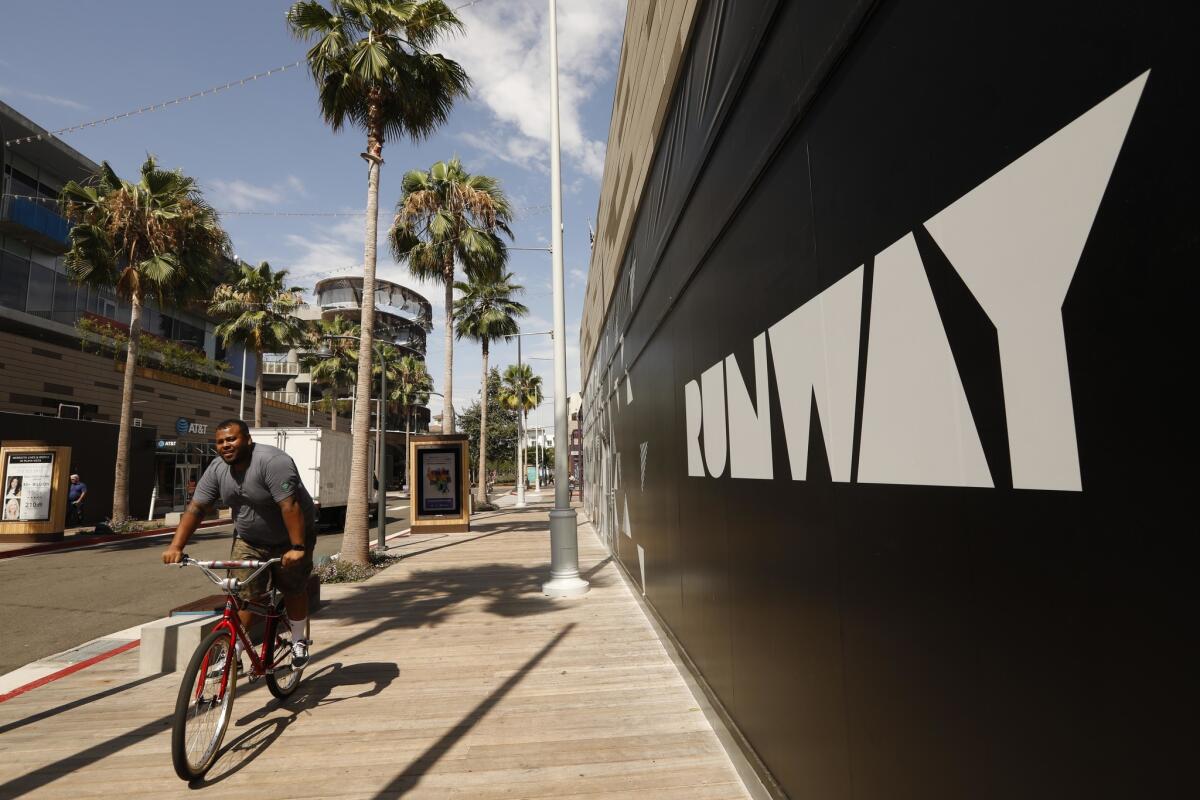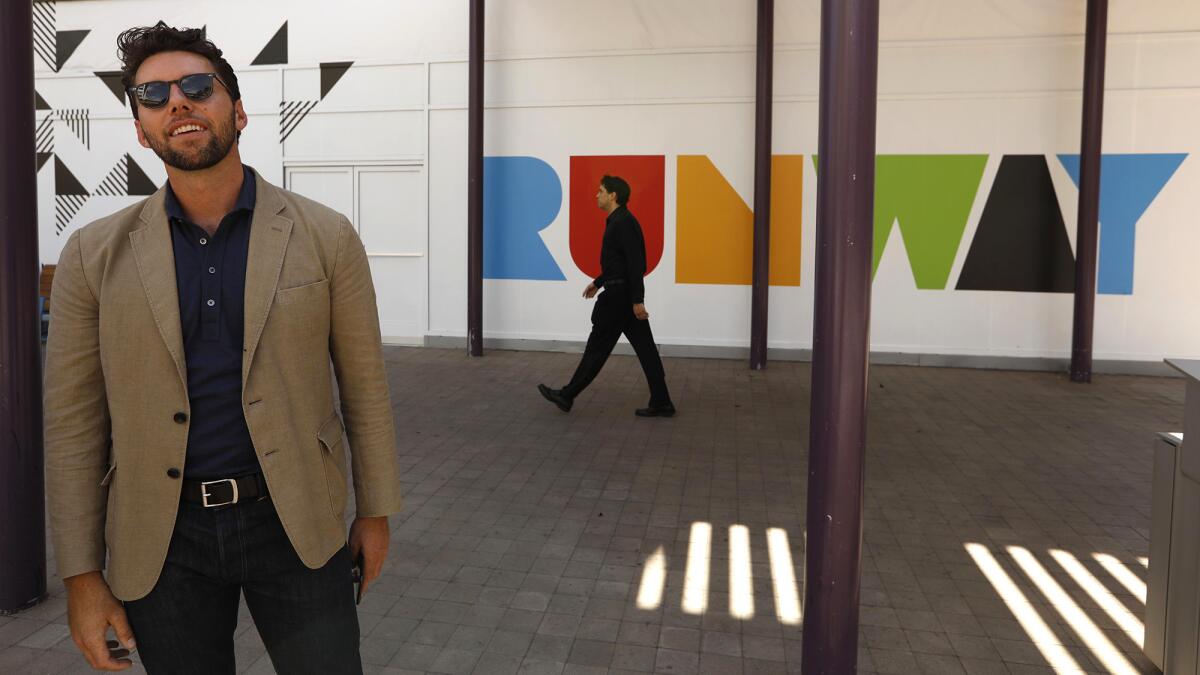Cars soon will be unwelcome on Playa Vista’s main drag. And a lot of people are happy about it

- Share via
On any given day, cars roll slowly down the main shopping street of Playa Vista, just as they do in small towns everywhere.
After all, when it came to building a town center on land around famed aviator Howard Hughes’s old airplane runway, it seemed right to let people drive through and perhaps park to grab a cup of coffee.
But those days are coming to a halt as the center, known as Runway, is being remade as a place where pedestrians will be more inclined to hang out, shop and eat — without having to dodge vehicles.
After seeing the closed-off streets packed with people during farmers markets and other special events, manager DJM Capital Partners Inc. concluded that Runway’s autocentric ethos was outdated and has decided to make the ban full time, even though the center was built only three years ago in the recently developed community.
The decision comes at a time when competition for shoppers’ favor is especially intense on the Westside, where established street corridors like Montana Avenue and Abbot Kinney Boulevard are contending with Santa Monica Place and Westfield Century City, malls that have both undergone major redevelopments.
And it reflects a national trend to favor people over cars in the hope of creating a sense of relaxed intimacy, something the pedestrian-oriented Grove “lifestyle center” in the Fairfax district pioneered more than a decade ago — but is now more imperative than ever as stores large and small stores go under in the face of changing tastes and online competition.
“We think one of the great saviors of retail is public space,” said Stenn Parton, senior vice president of retail at DJM. “We can fabricate foot traffic through programming and great on-campus experiences.”

Runway, owned by Invesco Real Estate, has more than 220,000 square feet of retail space and is about the size of four city blocks, surrounded by Jefferson Boulevard, McConnell Avenue, Millennium Drive and Village Drive. It features a Whole Foods Market, a Cinemark movie theater complex, shops and restaurants. There are medical offices leased to Cedars-Sinai and more than 400 apartments for rent.
The complex was planned to be the “downtown” of Playa Vista, a coastal community near Marina del Rey built last decade on land where mid-20th century business mogul Howard Hughes ran his aviation empire.
The first residents arrived in Playa Vista in 2002 and it already is home to 6,000 residences and 9 million square feet of offices. Tenants include Google, Facebook, Belkin and Sony, making it part of the coastal “Silicon Beach” strip of communities that begins north at Santa Monica.
There is already an indication that closing off the streets resonates with the population, which tends to skew younger, with the largest age group being people in their early 30s, many of whom are starting families. They have made the weekly farmer’s market a hit, helping it draw some 3,000 people, according to DJM.
Lisa Hirsch-Solomon, founder of fitness class center the Studio (MDR), is a supporter of permanently halting through-traffic in part because she believes the farmers markets have been good for her business.
“The more pedestrians we can get, the more eyes we have on the Studio and all the retail we have here,” Hirsch-Solomon said. “When you make it easy for people to walk around, sit down and enjoy a cup of coffee or eat something, it’s just so inviting.”
In Los Angeles, people might perceive closed streets as a panacea for salvaging underperforming retail strips because of the success of the Third Street Promenade in Santa Monica, but that is not necessarily so.
The Promenade, in fact, has been partially closed to traffic as far back as 1965 and it only really flourished in the 1990s as part of a downtown redevelopment program.
Real estate analyst Christopher Leinberger said that while removing cars on ailing main streets can encourage more foot traffic, it failed to spur business growth in most of the roughly 200 American cities that tried doing it during the latter decades of the 20th century.

“It was considered a silver bullet for instant urbanity, but mostly it put a bullet through the head of those main streets,” said Leinberger, a professor at the George Washington School of Business.
Street closures that are most likely to succeed take place on blocks where there are already active stores and restaurants, preferably supported by people who live upstairs or nearby.
“After density and excitement is there, then you close the street,” Leinberger said. “They got it backwards in the ’80s.”
Still, the scheme might work in Playa del Rey, he said. “It demonstrates this trend is viable.”
The vision for Runway’s $9.1-million makeover, which is expected to be completed early next year, is coming from architects Catherine Johnson and Rebecca Rudolph, principals of cheeky L.A architecture firm Design, Bitches.
Their thinking is that kicking out cars can help turn the town center into a place where people may want to stick around and connect with others.
“Once you give pedestrians the power to wander across and not worry about a car coming from one direction or another it frees up a lot what we can do in the street,” Johnson said. “We can take it from a place about shopping to a place about culture.”
To make Runway more inviting, several hard surfaces, including planters and concrete walls, will be replaced with lush landscaping, including billowing grasses and native plants. More benches will be installed, as well as spaces for gathering.
“Right now everything feels really tight and manicured,” Johnson said. “We want to encourage meandering and a sense of discovery and exploration.”
Already there are ideas about how a new culture can take form — think concerts, outdoor movie nights and art shows. DJM said it has found success with occasional night markets offering food, artisans and entertainment that draw up to 5,000.
Zachary Card, a retail property broker at CBRE who formerly represented Runway, thinks the makeover can do nothing but boost the shops along the street.
“You’ve got to give people an experience that is unique that you are not going to buy online or find in a big regional shopping center or mall,” he said. “People love open space, especially in dense urban environments” like Los Angeles.
Incoming store operator Lindsay Parton also sees a “really big benefit” to closing the street.
Parton is co-founder of Free Market, a new complex coming to Runway early next year that will have a mix of small stores and restaurants. She hopes to attract repeat business from people who live in Runway and nearby.
“We’d love to pull in people at multiple times the same day,” she said. “We’ll have a place to hang out that’s missing right now.”
Twitter: @rogervincent
More to Read
Inside the business of entertainment
The Wide Shot brings you news, analysis and insights on everything from streaming wars to production — and what it all means for the future.
You may occasionally receive promotional content from the Los Angeles Times.











